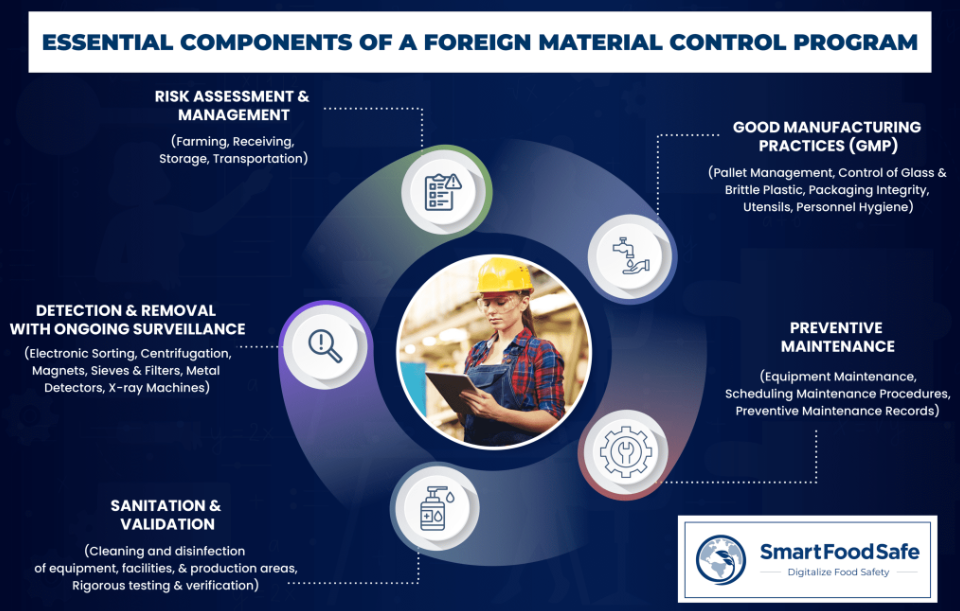
Did you hear about the recall initiated on June 30th, 2023, by the Food and Drug Administration (FDA) due to fragments of broken ink pens in ice cream pints?
As food products go through various supply chain stages such as farming, storage, transportation, receiving, manufacturing, packaging, and distribution, involving different facilities, processing procedures, and handling by multiple individuals, there are more opportunities for foreign objects to contaminate the food. Hence, it becomes imperative for food businesses to establish a systematic approach to foreign material control encompassing efficient and cost-effective methods to pinpoint and mitigate the potential risks from farm to fork.
Risk Assessment & Management in Farming, Receiving, Storage & Transportation
Risk assessment within the agricultural sector involves a systematic evaluation and analysis of hazards and vulnerabilities that could lead to the introduction or contamination of foreign materials in the farming process, from planting and cultivation to harvesting and post-harvest handling. Good Agricultural Practices (GAP) can play a critical role in these efforts. Complying with GAP brings robust foreign material control into agricultural practices by providing guidelines and standards that minimize the risk of contamination throughout the production process.
The safety and quality of materials delivered to food processing facilities are essential responsibilities during receiving and storage procedures. Risk assessment involves identifying potential sources of foreign material contamination in various stages, such as transportation, evaluating their likelihood, and assessing their impact on product safety. Bulk shipments, whether liquid or solid, pose significant challenges, with dry commodities often carrying the risk of containing foreign materials like rusted metals. To manage these risks, supplier verification and monitoring are crucial, ensuring adherence to stringent quality standards.
Good Manufacturing Practices (GMP, also referred to as ‘cGMP’ or ‘current Good Manufacturing Practice’) defines general measures to guarantee that processes necessary for production and testing to minimize foreign material contamination are clearly defined, validated, reviewed, and documented.
Personnel
Food manufacturers should institute policies concerning attire, hair restraints, and jewelry. Employee uniforms, typically provided by companies, should be manufactured from breathable, non-shedding materials and should not feature pockets above the waist. Uniform closures should involve snaps, zippers, or hook and loop fasteners, while buttons are best avoided due to the risk of detachment into products. They should often supply metal-detectable earplugs and brightly colored and metal-detectable bandages to employees. Verification programs should ensure the detectability of earplugs and bandages using metal detectors for each batch.
Premises
Implementing effective premise control measures is a non-negotiable aspect of the food industry to prevent foreign material contamination. It includes conducting regular maintenance of machinery and equipment to prevent any degradation that might lead to contamination, creating designated areas for different processes, reducing the risk of cross-contamination, installing screens and filters on openings to prevent pests from entering the premises and an operational waste management system to eliminate potential breeding grounds for contaminants. By adhering to these steps, food businesses can retain a safe and uncontaminated premise, safeguarding the integrity of their products.
Equipment Designing and Utensils
When designing equipment and utensils for the food industry, attention must be paid to preventing foreign material contamination. They should be crafted from materials that resist shattering or splintering. Opt for smooth and non-porous surfaces that are easy to clean, reducing the likelihood of residue buildup.
Select materials that are corrosion-resistant and food-grade, minimizing the risk of particles breaking off into the product. Metal utensils are the most suitable choice. In cases where plastic utensils are employed, regular inspection is essential, and any signs of chipping or splintering should lead to removal from service. Incorporate seamless welds and joints to prevent crevices where contaminants can accumulate.
Preventive Maintenance
A well-designed and managed preventive maintenance program that is developed, documented, and implemented based on the type of production operation is of great consequence in foreign material control efforts. Various equipment in a production setup requires different schedules for maintenance. Food processors should assess their operational processes to determine the appropriate timing and frequency for maintenance tasks. This is especially important for components with defined usage lifespans, such as gaskets, fittings, and drive belts. The goal is to replace such parts before they malfunction and pose an occasion for foreign material contamination.
Sanitation and Validation
Sanitation involves thorough cleaning and disinfection of equipment, facilities, and production areas. Validation, on the other hand, entails rigorous testing and verification to confirm that cleaning procedures and equipment are capable of consistently eliminating foreign materials. Manufacturers ought to contemplate broadening the scope of their cleaning validation activities involving an inclusive examination of the production line.
Detection and Removal with Ongoing Surveillance
Food manufacturers need to consider characteristics such as the type of product, production speed, sensitivity to contamination, and regulatory requirements when selecting and implementing detection and removal methods. The main kinds of equipment used to detect and remove foreign materials are concluded as:
Sieves and Filters
Electronic Sorting
Centrifugation
Magnets
Metal Detectors
X-ray Machines
Smart Food Safe paves the way for a streamlined and efficient foreign material control framework that upholds the utmost safety and quality in the food industry through our interconnected digital modules. Smart HACCP automates the identification and management of foreign material hazards with digital hazard analysis and Critical Control Point (CCP) and Preventive Control Point (PCP) implementation. Effortlessly develop a thorough policy and procedure documentation system for foreign material control with Smart Doc to maintain digital document compliance. Smart Record brings enhanced monitoring of foreign contaminant detection and removal strategies with the power of digital records. Guarantee foreign material control in the incoming raw materials by establishing a risk-based supplier approval and performance evaluation process as facilitated by Smart Supplier. Build a strong surveillance system for foreign material contamination through automation of audit management and improving compliance gaps with Smart Audit. Finally, maintain a well-informed and trained workforce on foreign material control protocols through our Smart Training.
_1.png)